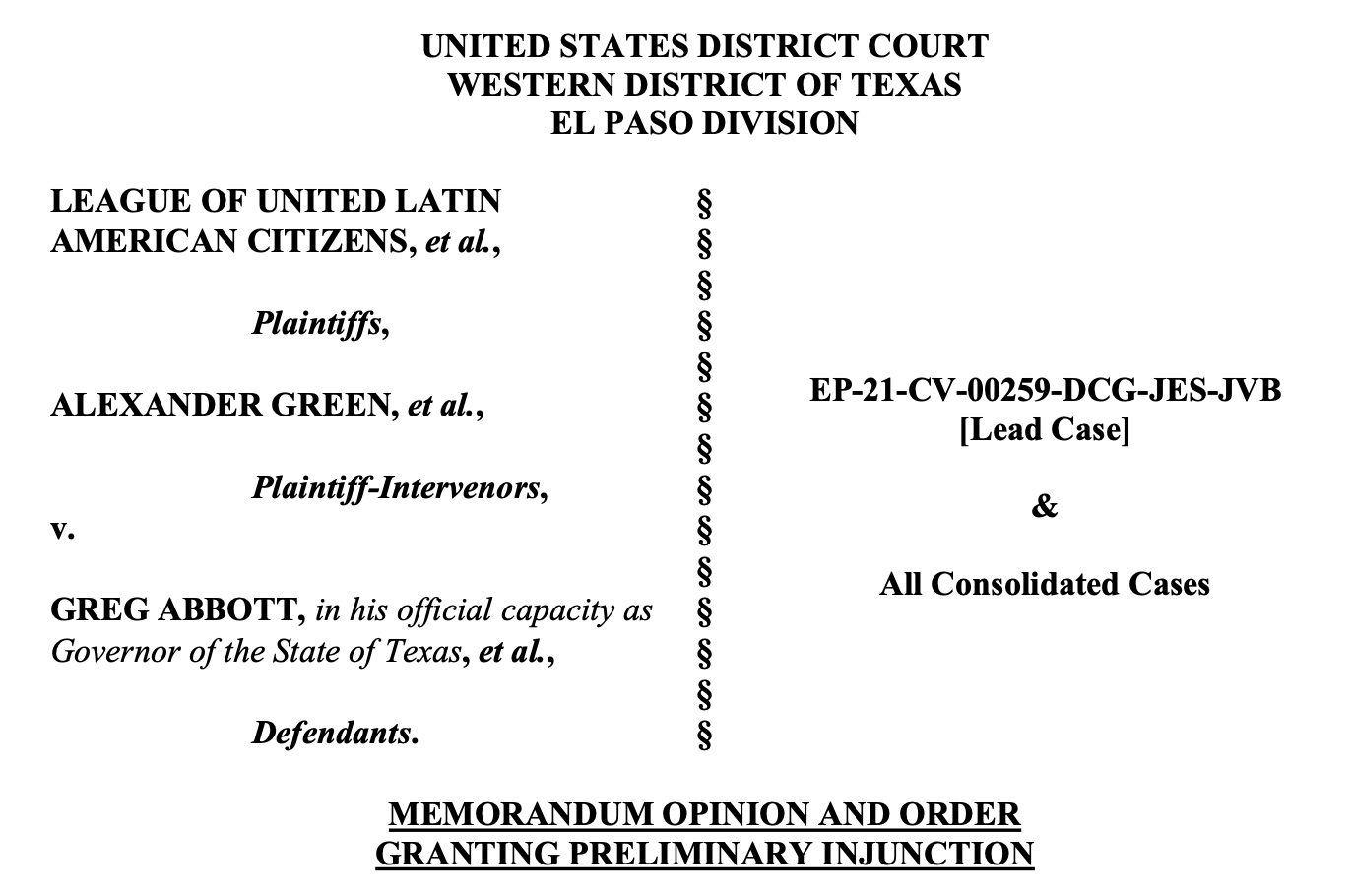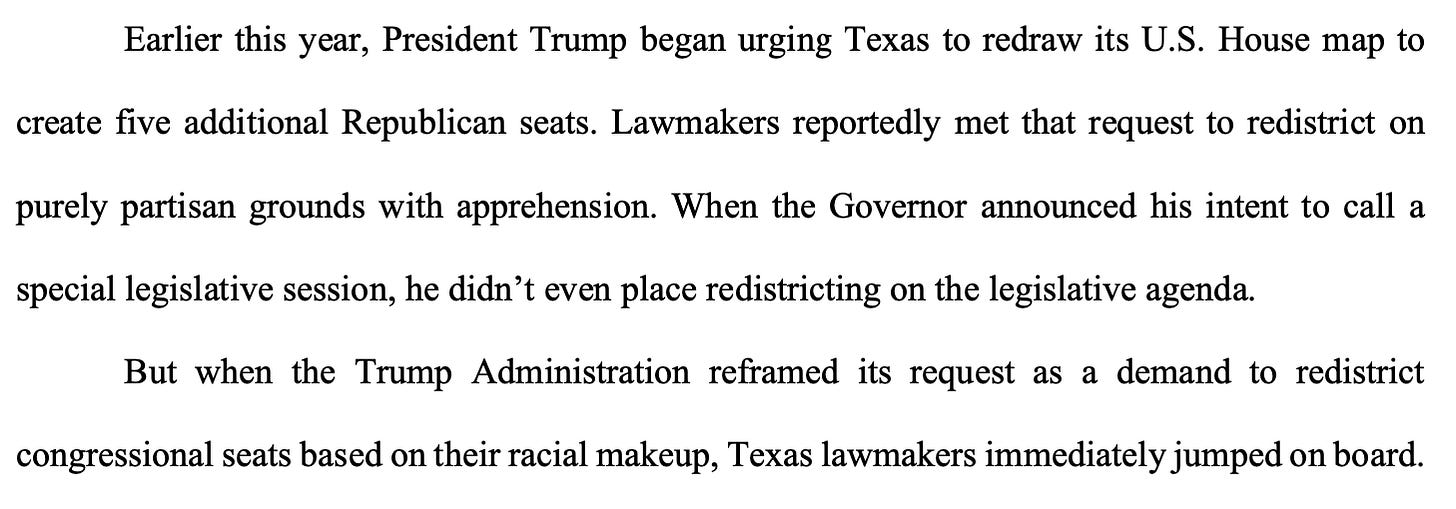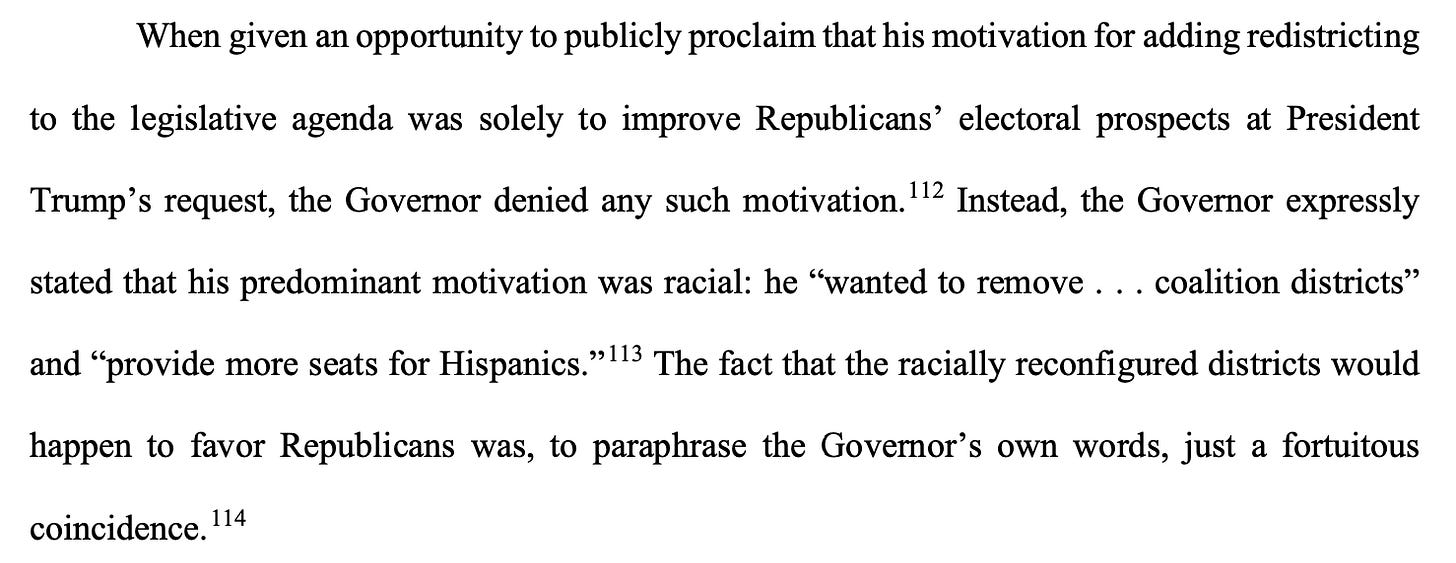Court blocks Texas redistricting, finding it likely unconstitutional, with DOJ largely to blame
"DOJ Asked Texas to Engage in Unlawful Racial Gerrymandering," a Trump appointee wrote for the 2-1 majority. Texas is appealing to the Supreme Court.
Texas’s mid-decade redistricting effort was likely an unconstitutional racial gerrymander, U.S. District Judge Jeffrey V. Brown wrote Tuesday on behalf himself and U.S. District Judge David Guaderrama.
“Without an injunction, the racial minorities the Plaintiff Groups represent will be forced to be represented in Congress based on likely unconstitutional racial classifications for at least two years,” Brown wrote of the challengers to the 2025 map.
As such, the two judges on the three-judge panel hearing the litigation over the effort granted the plaintiffs’ preliminary injunction request and ordered “that the 2026 congressional election in Texas shall proceed under the map that the Texas Legislature enacted in 2021.”
In redistricting litigation, cases are generally heard before a three-judge district court panel under 28 U.S.C. 2884. Such cases include two district court judges and one appeals court judge. Their rulings are appealed directly to the U.S. Supreme Court.
The circuit court judge here, Judge Jerry Smith, dissented from the ruling.
Nonetheless, before 5 p.m. CT, Texas had filed notice that it was appealing the decision to the Supreme Court.
The introduction from Brown, a Trump appointee, joined by Guaderrama, an Obama appointee, did a great job of summing up the problem here.
Specifically, he pointed to a July 7 letter from Harmeet Dhillon, the head of the Justice Department’s Civil Rights Division — a political leader who, as I wrote of DOJ more broadly in April in light of her confirmation, “will not be working to protect civil rights as we know them.”
Lest you think I’m being harsh, here’s what Brown — quoting the Texas Attorney General’s Office — wrote about the letter:
Of DOJ’s letter — specifically its legal interpretation of Petteway v. Galveston County, Texas, a recent en banc decision of the U.S. Court of Appeals for the Fifth Circuit — Brown extensively criticized the reasoning. Later, summing up discussion, he wrote that “the DOJ’s interpretation of Petteway … is obviously wrong.”
The dissent from Smith, a Reagan appointee, was not issued with the opinion and had not yet been issued by publication time, so it’s not clear yet what he thinks of all this.
At one point in his opinion for the court, Brown noted, “Far from seeking to ‘rectify . . . racial gerrymandering,’ the DOJ Letter urges Texas to inject racial considerations into what Texas insists was a race-blind process.“
When considering whether this was a partisan gerrymander — which the Supreme Court has held are not able to be challenged in federal court — rather than a racial gerrymander — which are subject to challenge — Brown, in part, turned to Gov. Greg Abbott’s statements:
In addressing the likelihood of plaintiffs’ succeeding on the merits of their racial gerrymandering claims, Brown wrote bluntly, “The direct evidence here is strong.“
The next section heading laid it out even more plainly:
The court went on to note Abbott’s statements as well. Brown then acknowledged that the state and federal executive branch officials statements are not “automatically imputable to the legislature,” but he continued:
Direct evidence in the preliminary-injunction hearing shows that key legislators in the 2025 redistricting process had the same racial objectives as DOJ and the Governor.
After going through the other preliminary injunction factors and finding that the plaintiffs should be able to have the 2025 map enjoined, Brown addressed the state’s argument that the Purcell principle — that courts “ordinarily should not enjoin state election laws in the period close to an election“ — counseled against an injunction.
“Rather than setting a hard cut-off, Purcell sets a flexible standard based on a fact-intensive analysis that considers the disruption an injunction would cause,” Brown wrote. “It’s not just about counting the number of days until the next election.”
What does that mean here? After stating that an injunction here “would not cause significant disruption,” Brown wrote:
In any event, any disruption that would happen here is attributable to the Legislature, not the Court. The Legislature—not the Court—set the timetable for this injunction. The Legislature—not the Court—redrew Texas’s congressional map weeks before precinct-chair and candidate-filing periods opened. The State chose to “toy with its election laws close to” the 2026 congressional election, though that is certainly its prerogative. But any argument that this Court is choosing “to swoop in and re-do a State’s election laws in the period close to an election” is wholly misdirected.
Ultimately, the majority concluded, “Reverting to the 2021 Map is the proper remedy here.”
Next up: The Supreme Court.
What about California?
Tuesday’s Texas map ruling will have no effect — at least not directly — on California’s redistricting authorized under Proposition 50.
The Trump administration intervened in a challenge to California’s post-Proposition 50 map, submitting its own complaint in the case. In it, DOJ alleges that the California redistricting is a racial gerrymander that violates the Equal Protection Clause and Section 2 of the Voting Rights Act. Briefing is ongoing and a hearing on the preliminary injunction requests is set for December 3.
Matthew Cooke and Rick Hasen just published a piece at Slate with much more on that litigation. Check it out!
Closing my tabs
For those who don’t what this is, it’s my effort to give a little thank you to paid subscribers. “Closing my tabs” is, literally, me looking through the stories and cases open — the tabs open — on my computer and sharing with you all some of those I was unable to cover during the week but that I nonetheless want to let you know that I have on my radar. Oftentimes, they are issues that will eventually find their way back into the newsletter as a case discussed moves forward or something new happens that provides me with a reason to cover the story more in depth.
This Tuesday, these are the tabs I’m closing:
Keep reading with a 7-day free trial
Subscribe to Law Dork to keep reading this post and get 7 days of free access to the full post archives.







